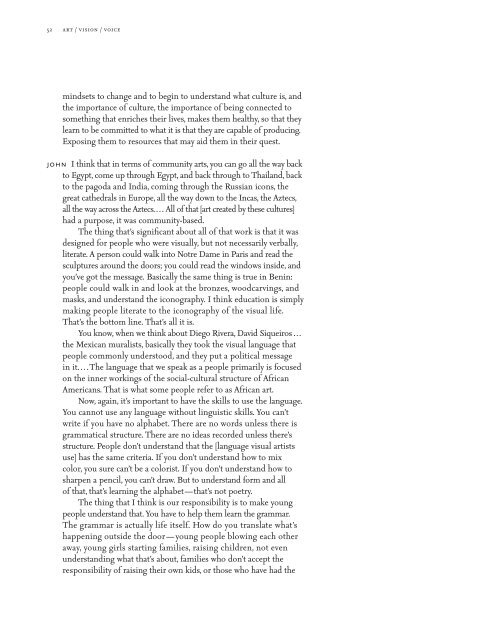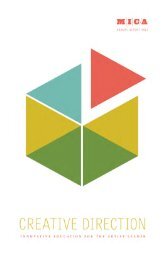art/vision/voice - Maryland Institute College of Art
art/vision/voice - Maryland Institute College of Art
art/vision/voice - Maryland Institute College of Art
Create successful ePaper yourself
Turn your PDF publications into a flip-book with our unique Google optimized e-Paper software.
52 <strong>art</strong> / <strong>vision</strong> / <strong>voice</strong><br />
mindsets to change and to begin to understand what culture is, and<br />
the importance <strong>of</strong> culture, the importance <strong>of</strong> being connected to<br />
something that enriches their lives, makes them healthy, so that they<br />
learn to be committed to what it is that they are capable <strong>of</strong> producing.<br />
Exposing them to resources that may aid them in their quest.<br />
john I think that in terms <strong>of</strong> community <strong>art</strong>s, you can go all the way back<br />
to Egypt, come up through Egypt, and back through to Thailand, back<br />
to the pagoda and India, coming through the Russian icons, the<br />
great cathedrals in Europe, all the way down to the Incas, the Aztecs,<br />
all the way across the Aztecs. . . . All <strong>of</strong> that [<strong>art</strong> created by these cultures]<br />
had a purpose, it was community-based.<br />
The thing that’s significant about all <strong>of</strong> that work is that it was<br />
designed for people who were visually, but not necessarily verbally,<br />
literate. A person could walk into Notre Dame in Paris and read the<br />
sculptures around the doors; you could read the windows inside, and<br />
you’ve got the message. Basically the same thing is true in Benin:<br />
people could walk in and look at the bronzes, woodcarvings, and<br />
masks, and understand the iconography. I think education is simply<br />
making people literate to the iconography <strong>of</strong> the visual life.<br />
That’s the bottom line. That’s all it is.<br />
You know, when we think about Diego Rivera, David Siqueiros . . .<br />
the Mexican muralists, basically they took the visual language that<br />
people commonly understood, and they put a political message<br />
in it. . . . The language that we speak as a people primarily is focused<br />
on the inner workings <strong>of</strong> the social-cultural structure <strong>of</strong> African<br />
Americans. That is what some people refer to as African <strong>art</strong>.<br />
Now, again, it’s important to have the skills to use the language.<br />
You cannot use any language without linguistic skills. You can’t<br />
write if you have no alphabet. There are no words unless there is<br />
grammatical structure. There are no ideas recorded unless there’s<br />
structure. People don’t understand that the [language visual <strong>art</strong>ists<br />
use] has the same criteria. If you don’t understand how to mix<br />
color, you sure can’t be a colorist. If you don’t understand how to<br />
sharpen a pencil, you can’t draw. But to understand form and all<br />
<strong>of</strong> that, that’s learning the alphabet—that’s not poetry.<br />
The thing that I think is our responsibility is to make young<br />
people understand that. You have to help them learn the grammar.<br />
The grammar is actually life itself. How do you translate what’s<br />
happening outside the door — young people blowing each other<br />
away, young girls st<strong>art</strong>ing families, raising children, not even<br />
understanding what that’s about, families who don’t accept the<br />
responsibility <strong>of</strong> raising their own kids, or those who have had the
















